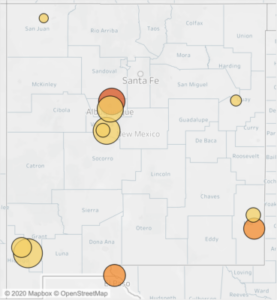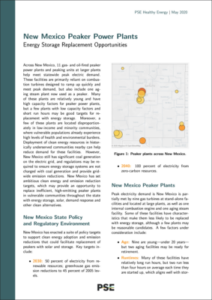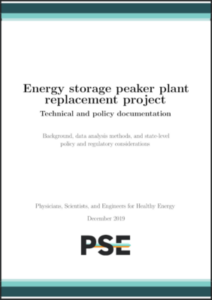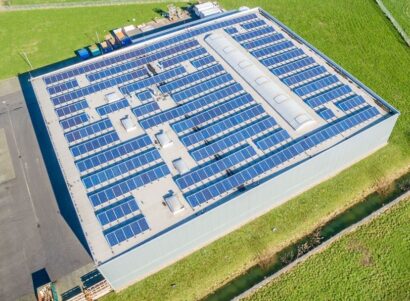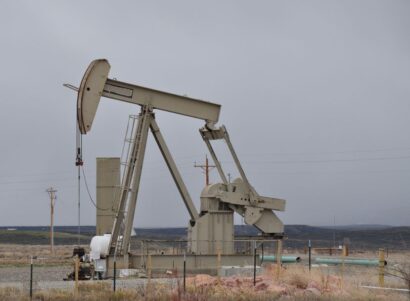Overview
In this analysis, we assess where solar and storage have the potential to replace existing New Mexico peaker power plants and where their deployment may yield the greatest environmental health and equity benefits. Across New Mexico, 11 gas- and oil-fired peaker power plants and peaking units at larger plants help meet statewide peak electric demand. These facilities are primarily reliant on combustion turbines designed to ramp up quickly and meet peak demand, but also include one aging steam plant now used as a peaker. Many are located in rural areas, but a few of these plants are located in urban, low-income and minority communities, where vulnerable populations already experience high levels of health and environmental burdens.
New Mexico has ambitious clean energy targets, including a goal of 50 percent renewable electricity by 2030, which can help support the replacement of the state’s most polluting peaker power plants with a suite of clean alternatives, including solar+storage, energy efficiency, and demand response. Many of New Mexico’s peakers are young, frequently used, and have long runtimes, but a few inefficient facilities with short runtimes and low capacity factors may be good targets for replacement with energy storage. As New Mexico still has significant coal generation on the electric grid, regulations may be required to ensure energy storage systems are not charged with coal generation and instead provide grid-wide emission reductions. In addition, deployment of clean energy resources in historically underserved communities near some of these facilities can help reduce demand for these plants while bringing equitable clean energy access. Storage is currently most cost-competitive with peaker plants, but moving forward this approach can set a precedent for displacing fossil fuel power plants across the grid.
New Mexico Summary: Read about our findings for energy storage peaker plant replacement opportunities. Technical Documentation: Look up data sources, methods, and a discussion of state-level policy and regulatory considerations. New Mexico Peaker Power Plant Map: Explore and visualize peaker plant data for gas- and oil-burning power plants used statewide to meet peak electric demand, including data on operations, greenhouse gas and criteria pollutant emissions, and nearby population demographics. We include combustion turbine, steam, and internal combustion power plants as well as units at larger plants that are 5MW or larger and burn oil and gas at a low capacity factor—less than 15 percent. The data do NOT include nuclear, solar, wind, hydro, biomass, coal, natural gas combined cycle, or geothermal generation.
New Mexico Peaker Power Plant Mapping Tool
Data are available in multiple views. Click below to explore:
- Statewide Map and Demographics: Map New Mexico power plants and visualize demographic data for nearby populations.
- Cumulative Vulnerability Index: Compare plants across an index of environmental, health, and socioeconomic burden indicators for populations living nearby.
- Individual Plant Demographic View: Search for data on populations living near an individual power plant.
- Individual Plant Operational View: Search for individual power plants and visualize historic generation and emissions data.
- Plant Indicator Ranking: Rank plants by selected environmental or demographic indicators.
- Data Comparison View: Select, compare, and plot user-specified data sets.
Quick Tips
- For a deeper view of specific maps or data: Select individual tabs on multi-tab visualizations.
- For a full-screen visualization: Click on the full-screen icon
 at the bottom right corner of a tab.
at the bottom right corner of a tab. - To download images or data from an individual plot or map: Click on the download icon
 at the bottom right of that figure.
at the bottom right of that figure. - To undo all filters: Click on the revert icon
 at the bottom right corner of a tab.
at the bottom right corner of a tab. - To embed or share a link to a specific map view: Click the share icon
 on the bottom right of your map results.
on the bottom right of your map results. - To re-center maps: Click on the home icon
 , which appears when you hover in the top left corner of the map.
, which appears when you hover in the top left corner of the map. - To look up terminology: Use the Glossary page.
New Mexico Peakers: Statewide Map and Demographics
Explore a map of New Mexico’s peaker power plants in relation to demographic indicators. Hover or click on an individual plant on the map to pull up its data. Use filters to select measures such as Plant Name or Plant Unit Type. Note: Certain plants have no nearby populations in a one-mile radius, in which case they will not appear in the figure on the right at this distance. Example question: Which plants are located in urban, low-income or minority communities?
Cumulative Vulnerability Index
We developed a Cumulative Vulnerability Index to compare the socioeconomic, health, and environmental burdens on communities living near each power plant. This index is calculated by averaging the state percentiles of populations living near each plant for three health indicators, ten environmental indicators, and four demographic indicators, and then summing the scores for these three categories. If the population near a plant scored the median value on every indicator, its index score would be the reference value of 150. For full methods, see the technical documentation. Below, select a Distance from Plant of 1 or 3 miles to compare the populations living within this distance of each plant. Note: Certain plants have no nearby populations in a one-mile radius, in which case they will not appear in the figure at this distance. Example question: Which plants are located in communities with high cumulative environmental, health and socioeconomic burdens?
Individual Plant Demographic View
Look up an individual Plant Name to find the demographics of populations living near the plant. Select a Radius of 1 or 3 miles to find average data for populations living within the chosen distance from the plant. Sample question: What is the total population living within one mile of a plant?
Individual Plant Operational View
Look up an individual Plant Name to find information such as where the plant is located and the plant’s historical generation and emissions. Use the Year filter to find the average annual generation and emissions over the selected time period. Click on additional tabs to view a table or figure on its own. Example questions: How many times does a plant start per year? How many hours does it run when it is turned on? Plant start-up periods have higher emission rates, and 3-5 hours might be a good match for energy storage.
Plant Indicator Ranking
Hover below a column and click the ranking icon to re-rank the plants by a given environmental, demographic or operational indicator value. By default, plants are ranked by capacity (size). Use filters to select the Plant Unit Type and the Distance from Plant used to aggregate population data. By default, the columns are ranked by the plant size (capacity). NOTE: Some data, such as generation on poor air quality days, are missing for certain plants. Example question: Which plants have the highest emission rates of nitrogen oxides (NOₓ) for every megawatt-hour (MWh) of electricity generated? A MWh of an alternative resource would have the greatest emission benefits from displacing a MWh from one of these plants.
Data Comparison View
Choose which datasets to compare to create your own plot. Select X-Axis Selector and Y-Axis Selector to choose two datasets to compare. Use the Distance from Plant filter to select population in a 1- or 3-mile radius from the plant. Note: Some data, such as run times, are missing for certain plants. In this case, individual plants without data will not show up under search bar. Sample question: Which plants are old and have low capacity factors? These might be good candidates for replacement.
More Information
See Glossary for definitions and Technical Documentation for methods and data sources.
Contact Us
To ask questions, make comments, report any errors in the data, or request a walk-through of the data visualizations, please contact Elena Krieger at: krieger@psehealthyenergy.org. These data are accurate to the best of our knowledge, but there are sometimes discrepancies in data aggregated from multiple sources and there may be errors in the compilation. We would appreciate your input if you notice any anomalies or inaccuracies to help us improve these visualizations. We are also eager to help you navigate and use the tool, so please reach out if we can help you use the tool to answer any specific questions! Top ↑
